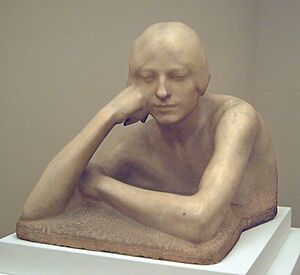Mateo Inurria facts for kids
Quick facts for kids
Mateo Inurria
|
|
|---|---|

Mateo Inurria (date of photograph unknown) from La Esfera (1915)
|
|
| Born | 25 March 1867 |
| Died | 21 February 1924 |
| Resting place | Cementerio de la Almudena |
Mateo Inurria Lainosa (born March 25, 1867, in Córdoba, Spain – died February 21, 1924, in Madrid) was a famous Spanish sculptor. He created many beautiful statues and monuments.
Contents
Mateo Inurria's Early Life and Art Studies
Mateo Inurria started learning art in his father's workshop. He went to the "Escuela Provincial de Bellas Artes" (Provincial School of Fine Arts) until 1883. There, he learned from a teacher named Rafael Romero Barros. From 1883 to 1885, he continued his studies in Madrid at the "Escuela Especial de Pintura, Escultura y Grabado" (Special School of Painting, Sculpture, and Engraving).
Mateo was very good at his studies. The local government of Córdoba, called the "Diputación Provincial," noticed his talent. They gave him a scholarship to study at the Real Academia de Bellas Artes de San Fernando (Royal Academy of Fine Arts of San Fernando). He studied there until 1890.
In 1890, Mateo showed his work for the first time at the National Exhibition of Fine Arts. His sculpture, "The Castaway," was so realistic that some judges thought it was made from a real person!
Working as an Artist and Teacher
Between 1891 and 1901, Mateo Inurria lived in the countryside. During this time, he didn't pay much attention to art critics or the public. He focused on becoming a teacher and an art restorer.
He worked on many important projects, like restoring parts of the Mosque–Cathedral of Córdoba and the ancient city of Medina Azahara. In these years, his art became simpler. He often said he was self-taught.
Mateo mostly created religious sculptures and monuments to remember important people. He received many requests to make statues for famous local and national figures. However, many of these statues were never actually put up.
Eventually, he became a professor. He taught modeling and figure drawing at the "Escuela Municipal de Artes y Oficios" (Municipal School of Arts & Crafts) in Córdoba. In 1901, he became the director of that school. From 1905, he sometimes served as a judge at the National Exhibition.
In 1911, he was named Professor of modeling and casting at the "Escuela de Artes y Oficios" in Madrid. He won the Gold Medal at the National Exhibition in 1920. Two years later, he became a member of the Real Academia de Bellas Artes de San Fernando. Mateo Inurria passed away suddenly in 1924. Today, an art school and a main street in Córdoba are named after him.
Famous Public Monuments by Mateo Inurria
Mateo Inurria created several important public monuments that you can still see today:
- Monument to Lope de Vega (1902) in Madrid. Lope de Vega was a famous Spanish writer.
- Group representing the Spanish Navy (1905) for the Monument to Alfonso XII in Madrid. This monument honors King Alfonso XII.
- Monument to Eduardo Rosales (1922) in Madrid. Eduardo Rosales was a well-known Spanish painter.
- Monument to the "Gran Capitán" (Gonzalo Fernández de Córdoba) (1923) in Córdoba. The "Gran Capitán" was a famous Spanish general.
See also
 In Spanish: Mateo Inurria para niños
In Spanish: Mateo Inurria para niños



